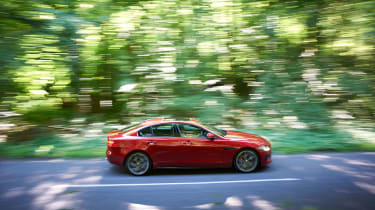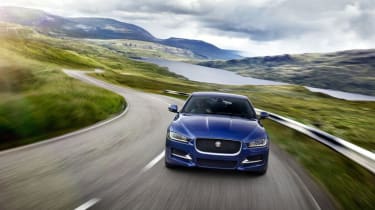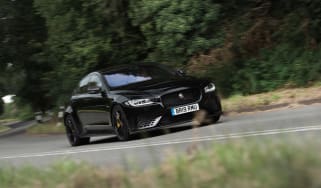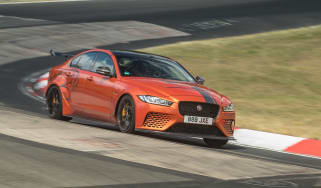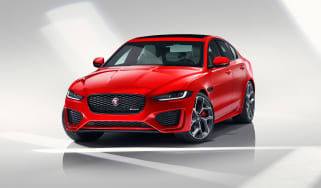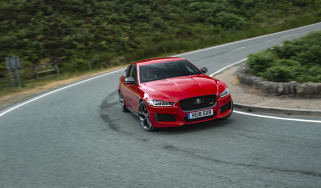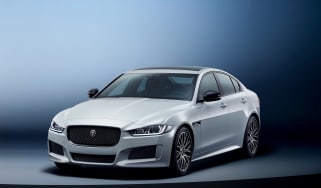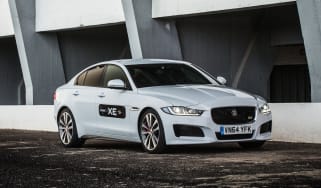Jaguar XE review - Jag's smallest saloon tackles BMW's 3-series head-on
XE's chassis is one of the best but lacks sparkle in other areas
Jaguar’s XE enters a fiercely contested segment of the market with a point to prove. The last ‘small’ Jag to be sold, the X-type, didn’t exactly set the world on fire and since then the Germans, Lexus and now Alfa Romeo have all moved the compact executive game on a long way. Further hurdles for the XE to overcome are ambitious cars trying to muscle into this sector from the one below, such as Volkswagen’s latest Passat and the fifth-generation Ford Mondeo.
A range re-shuffle has kicked out our previous favourite variant, the supercharged V6 XE S, but the existing range of petrol and diesels (and the hilariously potent XE Project 8) offer competitive, if not overly inspiring performance.
And that kind of sums up the XE. Its chassis is probably at the top of the class, but elsewhere it doesn't offer any great advantage over the competition, even if it's not really off the pace in any particular area either. It's a very good car but one lacking that final element of sparkle that you'd hope a brand like Jaguar could offer, particularly at a time when German equivalents aren't perhaps as desirable for drivers as they once were.
Jaguar XE in detail
> Engine, transmission and technical details - Range consists of a series of four-cylinder turbocharged petrols and diesels, plus the supercharged V8 of the Project 8. Automatic transmissions make the best of the power and torque on offer. Read all about the Jaguar XE's engine and gearbox here
More reviews
> Performance and 0-60 time - Range-topping XE 300 Sport doesn't quite make up for the loss of the V6 XE S, but the Ingenium 'four at least sounds better these days. Performance is competitive but not sparkling. Read all about the Jaguar XE's performance here
> Ride and handling - Dartier and more precise than most of its rivals, the XE is a sports saloon though and through. Read all about the Jaguar XE's ride and handling here
> MPG and running costs - The thriftiest diesel manages up to 57.6mpg, post-WLTP. Low CO2 figures and long service intervals should reduce running costs further. Read all about the Jaguar XE's MPG and running costs here
> Interior and tech - Some interior materials can be questioned, but the general design and feel is befitting of a Jaguar. The latest InControl infotainment system is vastly better than its predecessor but still lags the best in this class. Read all about the Jaguar XE's interior and tech here
> Design - Divides opinion in the evo office - it's slick and classy, but perhaps not as individual as you'd expect from a Jaguar, with hints of Audi and other marques to its detailing. Read all about the Jaguar XE's design here
Prices, specs and rivals
Kicking off the range is the £34k P250, powered by a 247bhp turbocharged 2-litre 4cyl petrol engine, driving the rear wheels through an eight-speed automatic gearbox. R-Dynamic models start at just over £35k, adding more kit as standard as well as more aggressive styling.
For the most entertainment in the XE range – short of the Project 8, which is a ludicrous £150k – you'll want the range-topping, 297bhp, P300 R-Dynamic model at just over £41,000, fitted exclusively with all-wheel drive and an eight-speed automatic transmission. Standstill to 62mph comes in just 5.7secs, putting it up against rivals such as the BMW 330i and Audi A4 45 TFSi.
The compact executive car market is a rather competitive place to be, with Germany bringing the BMW 3-series, Mercedes-Benz C-class, and Audi A4 to the table. As has been the case for perhaps the entire history of the segment, the 3-series is the best choice for those who enjoy getting behind the wheel. With the all-new G20-generation’s improvements to interior tech and refinement, it edges ahead of the XE.
The C-class fights back with a fantastic cabin, one that takes more than a few cues from Merc’s flagship saloon, the S-class. Audi's recently introduced A4 is a model of competence; incredibly quiet and refined, and capable (if not that involving) on a twisty road.
Elsewhere the choices are more diverse, but each has its own appeal. Volvo's S60 is getting on a bit now, but it has some of the comfiest seats in the business and a relaxed demeanour. The Lexus IS is worth a look too, with sharp styling, a sense of build quality to rival Audi, and the option of hybrid powertrains. The outsider's choice is the Infiniti Q50, but with its frankly bizarre-feeling by-wire steering you’d only choose it if you desperately wanted to look different; it’s really not that pleasant to drive.
Alfa’s Giulia is the compact saloon that really appeals to drivers. Whether it’s the 503bhp Quadrifoglio version, or the 2-litre petrol or diesel, the Giulia is the most focused small saloon on the market. All models come with super sharp steering, a carbonfibre propshaft and 50:50 weight distribution. The more ordinary models can also be specced with a limited slip differential (a torque varying LSD comes as standard on the Quadrifoglio), something that’s not an option on any of its competitors, not even the BMW. The LSD comes as part of a £1950 package that also includes variable dampers and wheel-mounted paddles.
> Read our review of the Alfa Romeo Giulia Quadrifoglio
The XE might offer a better all-round package than the Alfa – it’s more comfortable, more practical, it’s relatively handsome and it’s still fun to drive – but the Giulia is so much more exciting.
